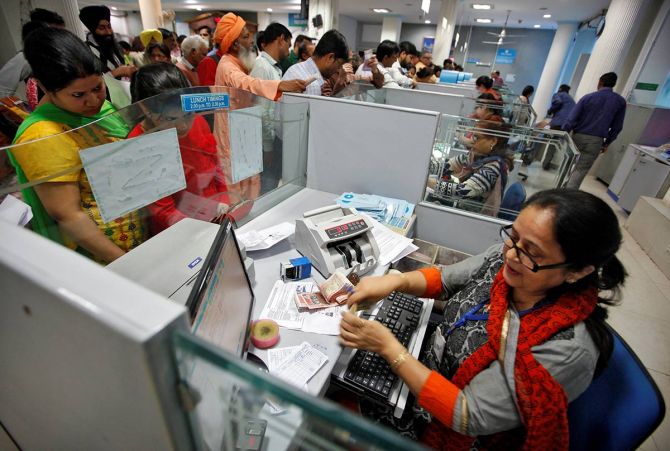Shifting to floating rate deposits can work as an anaesthetic gel for some customers, points out Tamal Bandyopadhyay.

In the rising interest rate regime, both banks and their customers have started feeling the pain, although for different reasons.
Let's talk about the customers first. The Reserve Bank of India recenty raised its policy rate by half a percentage point to 4.9 per cent.
This is the second rate hike since May 4, when the central bank had raised its policy rate by 40 basis points. One basis point is a hundredth of a percentage point. A series of rate hikes is set to follow to fight high inflation.
What does it mean for the customers? Their cost of borrowing is rising -- faster than before.
I don't have the latest figures but as of December 2021, little over 39 per cent of banking industry's loans are linked to external benchmark-based lending rate (EBLR), introduced in December 2019.
All loans given to the micro, small and medium enterprises (MSME) as well as retail loans are linked to EBLR. The banks primarily use the repo rate and, for some products, the 364-day T Bill rate as an external benchmark.
The repo rate has risen 90 basis points in the past two months. And the 364-day T Bill yield, which was 4.56 per cent around the time the first 40 bps rate hike was announced, has crossed 6 per cent (6.12 per cent). Many banks immediately raised their EBLR, each time the repo rate was raised.
This means if one had taken a home loan at say 6.7 per cent in April, one will have to pay 7.6 per cent now. For certain loans, linked to the 364-day T Bill yield, the rise is even steeper.
A study by the State Bank of India research says the impact of the first round of 40 bps rate hike on the MSME and retail borrowers is Rs 12,152 crore (Rs 121.52 billion), annually. As the rates rise, the burden will increase.
For every 1 bp rise in the repo rate, the interest cost for the borrowers will rise Rs 305 crore (Rs 30.5 billion(. This, of course, is the combined impact of EBLR as well as MCLR or marginal cost-based funding rate.
MCLR was introduced in April 2016, replacing the base rate that had been operational since July 2010. A miniscule part of the banking system's Rs 120.27-trillion credit is linked to base rate. They are legacy loans.
For every Rs 100 loan in SBI, the nation's largest lender, Rs 22 is given on fixed rates and Rs 78 on floating rates. Out of Rs 78, loans linked to MCLR are Rs 42, EBLR Rs 35 and base rate Rs 1.
Out of Rs 35 EBLR loans, Rs 23 is linked to repo rate and Rs 12 to T Bill. The overall industry scene won't be very different.
The main source of funds for banks is deposits. The base rate took into account the average cost of deposits while MCLR has been set on the marginal cost or the rate offered on new deposits. It was done to bring in more transparency and make the lending rates more responsive to the central bank's policy rate changes.
Banks do change the MCLR every month. They are required to reset the EBLR at least once a quarter but all of them have been doing this instantly, in the rising interest rate scenario. In December 2019 when EBLR was introduced, the repo rate was 5.15 per cent. By June 2020, it was cut to 4 per cent and remained there for two years till the rate hike cycle started this May.
The banks have been faster in raising their loan rates when the policy rate goes up, but not so prompt in paring rates when it goes down. Why? They can cut their loan rates only after paring their deposit rates, but that cannot happen overnight as the lower rates are applicable to only the new deposits while old deposits continue to cost more.
For MCLR, the banks are required to calculate their marginal cost of funds across maturities of deposits. They also add the so-called negative carry on cash reserve ratio (the portion of deposits that banks keep with the RBI on which they don't earn any interest), operating cost and a tenure premium for the risk associated -- the longer the tenure, the higher the risk. The final loan rate is decided on the spread over MCLR that banks charge.
No bank is allowed to price a loan below MCLR and the spread over MCLR can widen if the risk profile of a borrower deteriorates. Of course, fixed rate loans can be given below MCLR -- something they had indulged in when the benchmark prime lending rate or BPLR was in vogue.
The base rate was introduced in July 2010 with an understanding that no bank would lend below its base rate. It was supposed to be more transparent and fairer to MSMEs that had for so long been subsidising top-rated corporate borrowers.
Before BPLR, there was PLR or prime lending rate, introduced in October 1994. It was the rate at which banks used to lend to their top-rated clients and it had no relation to their cost of funds. Sometime early this century, RBI replaced PLR with BPLR.
For close to three decades now, Indian banking has been in search of a transparent, customer-friendly external benchmark rate that reflects changes in the policy rate.
EBLR is the answer but in a rising interest rate scenario it will pinch the borrowers hard. Typically, when the rates rise, for the existing borrowers, the banks lengthen the tenure of the loan instead of raising the amount of equated monthly instalments.
The rising cost can dampen the loan demand and also dent a borrower's ability to service the loans. Particularly, the MSME sector, which is yet to get over the shock of the Covid pandemic, will be hit hard. It's a double whammy -- affecting both economic growth and the quality of assets of the banking system.
The banks will also feel the pinch as their treasury income will be hit. In fact, many will end up booking losses as the yield on government bonds is on the rise. Prices and yields of bonds move in opposite directions.
The 10-year bond yield, which was 5.52 per cent on March 30, 2021, has crossed 7.5 per cent. At the shorter end, the spike in yield is even sharper. For instance, the 364-day T Bill yield has risen from 3.83 per cent to 6.12 per cent during this period.
The banks are required to invest 18 per cent of their deposits in government securities but the average investment is around 26 per cent now. Theoretically, 23 per cent is covered from any notional losses as they can be kept in the held to maturity (HTM) basket but most banks have been keeping less than 21 per cent in HTM.
For the rest, when the prices drop, they need to book mark to market (MTM) losses. MTM is an accounting practice whereby an asset is valued at the market price and not at the price it is bought. So, when the prices drop, the difference between the purchase price and market price has to be provided for.
Of course, the extent of treasury loss depends on the pace of rate hike. In the first quarter of FY23, when the rate has risen by 90 bps, most bank treasury is staring at losses as the 10-year bond yield has risen from 6.18 per cent to 7.51 per cent during this quarter. If the rise in rate is gradual, they can stomach it.
Also, as only new deposits earn higher rates but most floating-rate loans are instantly repriced, banks' interest earning rises to even it out. In fact, higher interest income can more than compensate for treasury losses.
So, the banks have a balm for their pain. Probably, shifting to floating rate deposits can work as an anaesthetic gel for some of the customers.
Tamal Bandyopadhyay, a consulting editor with Business Standard, is an author and senior adviser to Jana Small Finance Bank Ltd.











